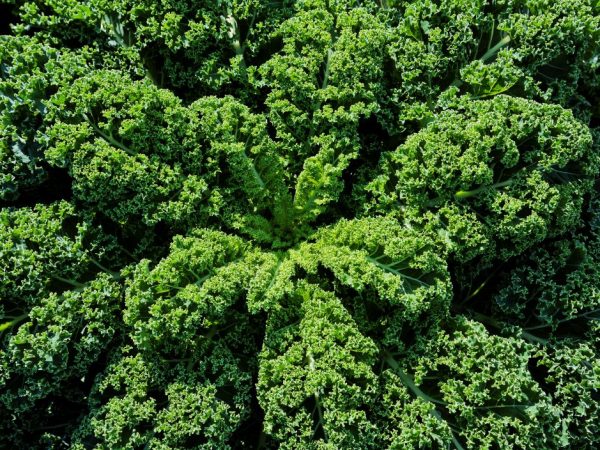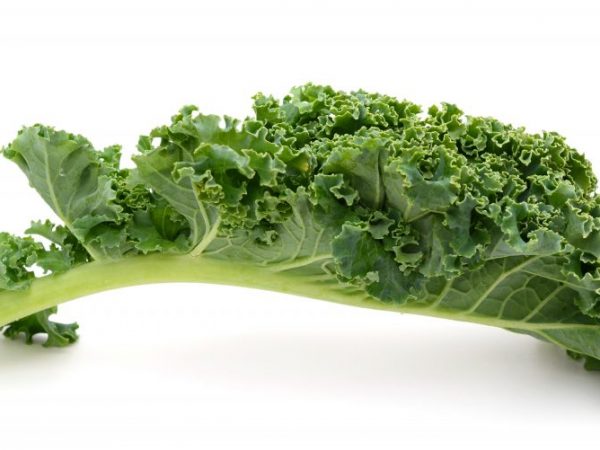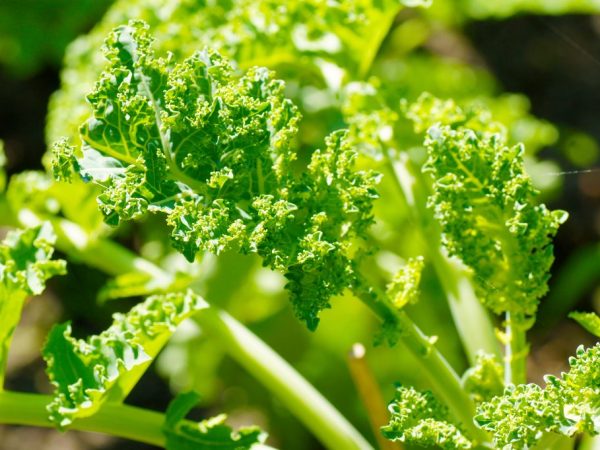Characteristics of kale
All other varieties known today were derived from the fork type of cabbage. Kale is called Kale (or Kale) and is one of the types of kale, most popular in Europe.

Characteristics of kale
Characteristics of the variety
All types of kale (kale) cabbage have been bred from wild plants. The variety is unpretentious, it can be grown in any region, as it is resistant to various pests and can withstand temperatures down to -18 ° C. The variety is also used in landscape design.
Kale got its name because of the specific shape of the leaves. They are:
- flat with slight wavy edges;
- rounded with wavy edges of medium density;
- rounded with elongated wavy edges.
The height of the plant can also be different: from 40 to 90 cm.The color varies from green to red. The most famous types of kale:
- Black Tuscany. This kale is light green in color, its leaves have an unusual lumpy structure. It is mainly found in southern countries.
- Reflex F. The variety is distinguished by its dietary properties. Only 100 g can provide a person with a sufficient amount of nutrients.
- Redbor F. A bush of unusual purple color, soft in taste. It is better to grow it in sufficiently lightened areas. The more light, the more beautiful the bush looks.
- Reed or reed. It has strong leaves, reminiscent of lettuce bushes. It goes well with exotic dishes.
- Siberian. It is disease resistant and can yield at very low temperatures.
- Tintoretto. This variety tends to become even more delicious after freezing.
Description of the head
A distinctive feature of this variety is the absence of a head of cabbage.
Unlike the “stone head” variety, this plant is more like a salad. Some varieties are grown to decorate the backyard, as they look very beautiful. The plant contains many useful substances: flavonoids, anthocyanins, antioxidants.
All modern varieties were bred from a wild plant, so they are similar in chemical composition. Grunkol contains many vitamins C and K, as well as vitamins A, B1, B2, B3, B6, B9, E and omega-3 fatty acids.
Beneficial features:
- can replace meat dishes;
- has a good effect on vision;
- reduces the amount of cholesterol;
- optimizes digestion;
- has a positive effect on blood clotting;
- reduces the risk of tumors.
It has a good effect on the immune system, increases the level of the body's defenses. This happens because the regular use of feces prevents viruses from entering the body and increases hemoglobin, gives oxygen access to the internal organs of a person.
Kale is stored in a cool place: high temperatures negatively affect its taste. You don't even have to dig it out for the winter, but just leave the roots in the ground and enjoy the harvest again next season.
Application of the vegetable

The variety is suitable for salting
Kale, along with broccoli, is often used in diet menus.Fresh juices and fresh juices are prepared from it. Thick leaves are suitable for pickling and pickling. Kale is also added to lasagna.
Recipes
One of the more unusual recipes is curly cabbage chips. Tear the leaves, add salt, pepper and mix with oil, then line them on a baking sheet covered with parchment and place them in an oven preheated to 100 ° C. Keep until ready.
Green kale goes well with tomatoes, green onions and basil. Salads are best seasoned with pumpkin or olive oil.
One of the dietary options for a dish with kale is a salad with beans. For cooking, take 500 g of cabbage, a can of beans, 200 g of tomatoes, oil, salt, 4-5 spices. All vegetables are chopped, the leaves are torn by hand, the ingredients are mixed and a sauce of oil and spices is added.
Contraindications
Despite the large number of useful properties of the product, collard greens also has a number of contraindications. Curly cabbage can be harmful to people with kidney or gallbladder disease. Abuse can cause flatulence, stomach cramps, or diarrhea.
Care
To grow a good harvest, it is important to water the seedlings in a timely manner, loosen and nourish the soil. When the plant reaches 20-25 cm in height, it is huddled, and the weak leaves are immediately torn off. In order to facilitate maintenance and protect the variety from root rot, you can fertilize the soil with humus or compost.
Watering
It is important to follow the watering rules. To avoid spreading water, a small furrow is made around each seedling, water is poured directly into it. In the heat, the plants are watered more often and do not forget to loosen the ground. The soil should be slightly damp.
Top dressing

It is necessary to nourish the plant every 7-8 weeks. This is done for the first time during the period of active leaf growth. For fertilization use herbal infusion. The fourth part of the container is filled with water, then fresh grass is added (10 kg per 100 l of water) and 2 kg of chicken manure are added. The solution is insisted for 2-3 days. Fertilizer is applied only at the root of the plant.
Diseases and pests
Diseases and pests of the variety:
- aphid;
- scoops;
- whites;
- color beetle;
- wireworms;
- slugs.
You can protect the plant by sprinkling the soil with wood ash, tobacco dust, or a mixture of these, but after rain it is important to repeat this procedure. Spraying with a 70% vinegar solution diluted in water will be effective.
Chemical methods of struggle can also be used, it helps well:
- Kemifos;
- Aliot;
- Bankcol;
- Kinmix;
- Fury.
These measures should be applied only when folk methods are powerless and it is necessary to save the harvest.
Prophylaxis
To protect plants from diseases, you need to adhere to the rules of crop rotation, pickle seeds before sowing, remove weeds and sucking pests from the site in time.
Conclusion
Curly cabbage is a nutritious, unpretentious vegetable. Many years ago it was used for decorative purposes, but now it is confidently gaining a place in the kitchen.
The vitamins in its composition make it a good medicine for many diseases. Despite the beneficial properties inherent in it, one should not forget about contraindications and be careful with the use.


